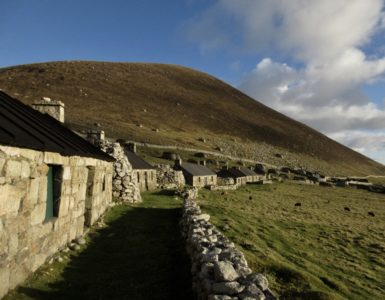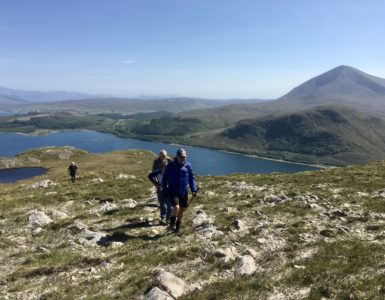David Gilchrist explains his seamless transition from Munro Bagger to Marilyn Bagger
One glorious summers day in 1987 I walked quickly up Ben Vorlich above Loch Earn. Shortly after that, I discovered I was a Munro bagger.
I was extremely lucky to walk/climb all the Munros accompanied by my son. Our last Munro being Ben More on Mull in 2006. The only Munro on an island - if you discount Skye due to the bridge.
The natural progression was then the Corbetts which, although I walked many alone, I enjoyed more than the Munros. I especially enjoyed the 9 Corbetts on the islands of Harris, Rum, Mull, Jura and Arran. The Corbetts also tended to be less frequented than their bigger more popular peers. The SMC guidebooks proved to be excellent and in general route finding was straightforward. J R Corbett clearly defines his list as hills between 2500 and 3000 ft high with a 150 m (500ft) drop or prominence. Only recently have I discovered that this 150 m drop clearly identifies a unique hill with (almost) always a great view - especially from those coastal hills. Unfortunately, the Munros have no “required drop” so a few of them tend to have limited views from a high plateau. There are also many delightful, but challenging, Corbetts in Ardgour where there are no Munros.
In 2014 I completed the Corbetts and started on the Grahams - hills between 2000 and 2500 ft high with a 150m drop. While obviously not as high, these hills are significantly different to Munros and Corbetts. Less, if any, paths exist and route-finding can be tricky especially at lower levels where access points can quickly change, and trees always keep growing and are then harvested causing, even more, change and confusion. For me, the relatively new (2015) SMC Graham's guidebook is, to be polite, not as accurate or well researched as the Munros/Corbetts books. However, there are many fabulous and prominent Grahams around the coast and 14 on the Scottish islands.
While walking the Grahams I occasionally detoured to other surrounding and prominent hills and this is how I discovered the Marilyns - hills of any height in the UK but with a 150m drop. I quickly walked all my local Marilyns and soon realised that many were around the coast and on islands giving fabulous uninterrupted views in areas where the weather can often be better than in the higher mountains. The 333 Marilyns in England and Wales also give a wider range of areas to walk throughout the UK with the weather usually being slightly warmer/drier further south and then there are the 5 Marilyns on the Isle of Man. Access and route finding for Marilyns can pose similar issues to those encountered when accessing Grahams. When I discovered the Database of British and Irish Hills (DoBIH) with ticklists available via Hill Bagging) and joined the Relative Hills Society most of my walk planning issues quickly disappeared. Having always used guidebooks and paper maps for most of my walk planning, converting to digital maps and routes was a big step forward.
Thank You to all involved in both DoBIH and RHSoc!
There are over 200 Marilyns on Islands throughout the UK so the logistics of organising a trip to some can be quite demanding-especially the St Kilda Group of 6. One island Marilyn that I had wanted to visit for many years was Ailsa Craig so earlier this year I organised a RHSoc trip to this rocky island 10 miles off the Ayrshire coast (Ailsa Craig climb described here).
The only jetty on Ailsa Craig is located on the North East of the island which cannot be used at low tide or when there is significant wind from the north and east-therefore booking a boat for a good weather window can be a bit of a lottery. Despite this 10 of us managed to land on Ailsa Craig in August this year- almost exactly 33 years after my first ascent of my first Munro in 1987. The short, steep and slippy ascent (338m) of Ailsa Craig is much faster than the boat trip and the summit gives great views across Arran and the Galloway hills from a totally different perspective.
There are many other hill lists from Wainwrights to Tumps to Ultras - most of which are now defined by their prominence or drop. Tumps require a drop of only 30 m (so there should be a few nearby) while for Ultras the drop is 1500m so they are only overseas. The following list compares the number of hills on each list and the number of walkers that are currently registered as having completed the lists I have mentioned:
- c280 Munros, c 7000 completions
- c222 Corbetts, c700 completions
- c219 Grahams, c200 completions
- c1550 Marilyns, c10 completions
In conclusion, there are a great number of great hills in the UK and it is all thanks to Sir Hugh Munro who initiated the idea of hill bagging which has subsequently been improved/expanded by Corbett, Donald, Dawson and many others. For further info please refer to RHSoc and DoBIH.





Add comment